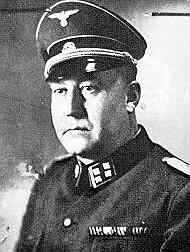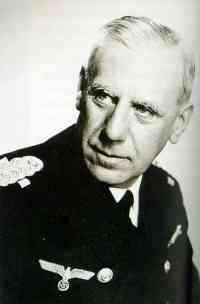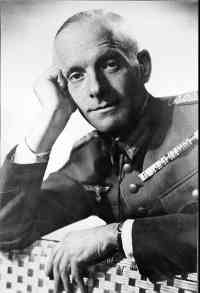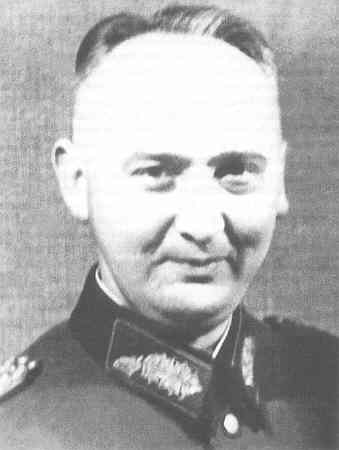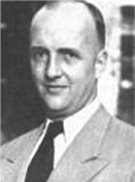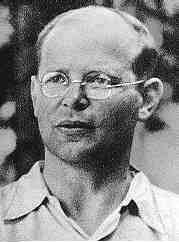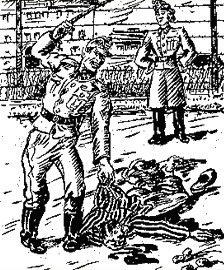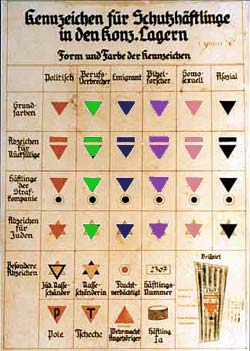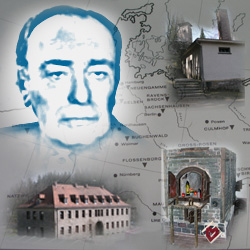 |
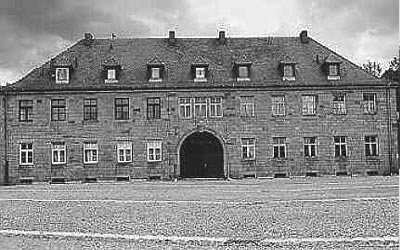
FACTS: The Konzentrationslager [concentration camp] Flossenbürg was established at the beginning of May 1938 in the northern Oberpfalz of Bavaria near the Czechoslovakian border (today Czech Republic) as a prison and working camp for professional criminals and asocial citizens like vagrants, beggars, homosexuals, habitual drunkards, psychopaths, etc. [note: KL was the official abbreviation for concentration camp but KZ is the more widely used and known] Three mayor reasons to establish this concentration camp were without no doubt the rich granite stone occurrence existing in this area, the remote location and the proximity to the border with the look at the east lying countries. Altogether 100.000 [estimated] prisoners were interned from 1938 to 1945 in the main and the external camps. At least 30.000 did not survive the terror through purposeful murdering or by the catastrophic living conditions. Since however in Flossenbürg arriving prisoners in the final phase of the camp were not any longer registered and the registration numbers of dead camp prisoners were assigned partly again to new prisoners, the number of the victims could be never determined accurately. Prisoners where marked by multi color triangles sewn on the clothes (left chest and right leg) and this way divided into categories, the so-called Winkels. Red stood for political, green for criminals, blue for immigrants, violet for bible researchers and Jehovah's witnesses, pink for homosexuals and black for asocial prisoners. Brown was formerly the color for gypsies, but later they joined the black triangles. Additional marks were used for Jews, etc. The privileged criminal Grünwinkel [green triangle] occupied however important positions within the prisoner hierarchy and developed to a considerable degree of willingness helpers, the so-called Kapos of the SS. Such, already in Dachau tested camp structure had method: green Kapos became the instrument of the terror against other prisoners. That should prevent solidarism of the prisoners among themselves, destroy any private sphere and individuality and create a constant pursuit and destruction pressure. The unbelievable camp conditions, the terror of the wardens and the Kapos determined the camp's everyday life. Fernand Van Horen, a Belgium artist and inmate of KZ Esterwegen wrote: "...on March 10th, 1945, we are all sent to a death camp [Flossenbürg]. The conditions of life are incredible. Nobody can imagine the bestiality and the cruelty of the SS guards. It is really hell here! And there are very few survivors of this hell! We entered a barrack and are immediately faced with what will be common for us in the next months; an inmate is beaten to death with a whip. We don't know the reason why this poor fellow is beaten to death. Torture, shootings, hangings, all of this is just normal life in Flossenbürg. The most common threat of the SS is Krematorium [crematorium] !" Although the KZ Flossenbürg did not have the character of a pure extermination camp, the hard work, the insufficient nutrition and supply in the camp, as well as the daily perverse chicaneries of the wardens would do this by its own. "Extermination through work" was the slogan given by Himmler to the SS, hitting exactly the point in Flossenbürg where prisoners were exploited by forced labor up to the highest degree. Human life was considered as an exploitable raw material in the production of war-important goods. Since by arbitrary arrests Nachschub [supply] was delivered at any time, human beings had only a small value. The first prisoners [political], who came starting from May 1938 with transportation from the KZ Dachau, had to establish first administration buildings and the barracks as well as protection systems. At the same time however they started with the first forced labor in the granite quarry of the SS own business enterprise DEST (Deutsche Erd- und Steinwerke). But both, the prisoner structure and the character of the forced labor changed already when war started. Production for the wartime economy became ever more important. At the end of 1942 it was planned to establish production plants of Messerschmitt [Airplane Industry] in Flossenbürg. Until 1943 the prisoners were used predominantly in the quarry and systematically tortured and humiliated by the SS wardens and the Kapos. Starting from February 1943 a part of the prisoners was then used for the production of the airplane fighter Messerschmitt ME 109. With the extended war-economical prisoner work expanded the concentration camp of Flossenbürg also geographically. Starting from 1942 in Bavaria, Boehmen and Saxonia over 100 external commands of the main camp were established. Ten thousands of prisoners were forced there to slave work - many did not survive. 1943 already seized the camp over 4000 prisoners, mainly political prisoners from foreign countries: Poland, Soviet prisoners of war and civil workers, Czechs, Belgians, French and Netherlands. From mid 1944 numerous Polish and Hungarian Jews met in Flossenbürg, who were forced to slave work before their planned extermination. But also additionally purposeful and systematic extermination actions took place. For that reason for example, in September 1941 a separated secured range was created within the actual Schutzhaftlager for Soviet prisoners of war with a capacity of 2000 men. The russian inmates were murdered in great quantities. Since these prisoners were not officially registered, only assumptions can be employed over the number of deaths, but the mayor part was killed. "During the 12 months preceding the liberation, Flossenbürg and the branch camps under its control accounted for the death of 14,739 male inmates and 1,300 women. These figures represent the deaths as obtained from the available records in the camp. However, they are in no way complete, as many secret mass executions and deaths took place. In 1941 an additional stockade was added at the Flossenbürg camp to hold 2,000 Russian prisoners. From these 2,000 prisoners only 102 survived. Flossenbürg Concentration Camp can best be described as a factory dealing in death. Although this camp had in view the primary object of putting to work the mass slave labor, another of its primary objectives was the elimination of human lives by the methods employed in handling the prisoners. At the end of 1944 lived over 8000 prisoners in the barracks of the main camp which was aligned for maximally 5000 prisoners, predominantly from Poland, the Soviet Union and Czechoslovakia. More than 5000 of them were assigned in the production of the ME 109 fighters. At the same time already nearly daily prisoner transports arrived from other concentration camps like Auschwitz, Buchenwald and others. Due to its geographical location Flossenbürg became temporarily the catching station for thousands of prisoners, who were driven south from the SS before the nearing allied. At the beginning of February 1945, around 15.000 humans where living in the main camp. No prisoner should fall living into the hands of the Befreier [liberators]. The SS wardens tried to cover the traces of their murder activity in the abandoned camps, they burned discriminating papers, personal main files, etc. but with the increasing confusion and time running out for them, they did not archive completely their goal. In addition starting from March, first transportation left toward the south; the camp was dissolved. On so-called evacuation marches in the following days without food and well over 10.000 completely exhausted prisoners, many of them died weakened and by the accompanying security guards which shot or simply killed them. After end of war over 5.000 dead ones along the routes were discovered. At the beginning of 1945 a group of Sonderhäftlinge [special prisoners - members of the military resistance and high-ranking representatives of different states] from Gestapo and armed forces prisons and other camps arrived at Flossenbürg. They where separated in a special area called the Bunker and did not have contact to the other prisoners nor did they have to work. In the directly bordering prison yard, surrounded by a wall, many of them were executed (estimated: 1.500 political prisoners during the last year of war). The last trail took place on April 8, 1945 were a group of Sonderhäflinge were sentenced to death by the SS judge Dr. Otto Thorbeck and under accusation of the SS Standartenführer Walter Huppenkothen in a bogus trial [no witnesses, no defense, no protocols, SS Obersturmbannführer Kögel as assessor] and executed in the early morning hours of April 9, 1945. The men from the group of resistance of the 20. Juli 1944 [assassination attempt against Hiltler], briefly before brought to Flossenbürg were: Wilhelm Canaris, Ludwig Gehre, Hans Oster, Karl Sack and Dietrich Bonhoeffer. They where hung naked under the gibe and laugh of the SS men. Only a few days later on April 23, 1945 the 90. US Infantry Division liberated the concentration camp Flossenbürg (The Division - nickname: Tough Hombres - was recognized as a liberating unit by the U.S. Army's Center of Military History and the United States Holocaust Memorial Museum in 1985). US soldiers found there still approximately 1.500 seriously ill prisoners in a heartbreaking and terrible physical condition, which had been abandoned and left back in the camp by the fleeing security guards. Many of them survived their liberation only a few hours or days. In the following weeks many inmates died at the consequences of the camp detention. Approximately a third of the prisoners of the concentration camp did not survive their liberation at Flossenbürg. US Officer Albert A. Salt wrote a note: "Hadn't had any sleep for 24 or 30 hours and after having seen 200 or more dead bodies that the S.S. troops didn't have time to incinerate. The prisoners were dying at about 50 - 75 a day when we first arrived. We had the job of incinerating the dead and trying to feed the living. I still have a feeling of sickness whenever I smell flesh burning..."
Today a memorial place reminds of the suffering and the death of the prisoners. |
|
|
|||||||||||
|
|||||||||||||
|
|||||||||||||
|
|||||||||||||
